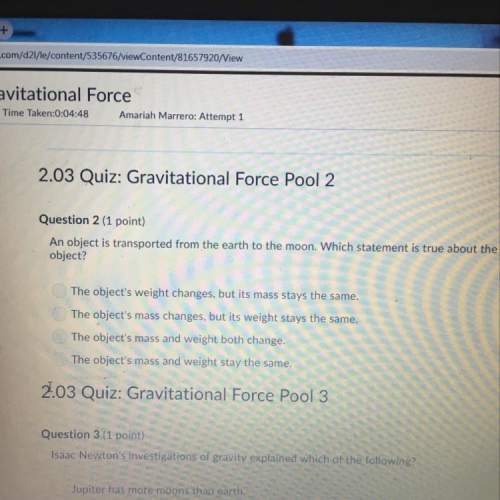
Chemistry, 21.10.2020 01:01 sparky1234
Use the information below to answer the following two questions.
Emily described the procedure she uses to make and Sake dough balls in the table below.
1. Measure 50g of yeast.
2. Measure 175 mL. (g) of water and pour it into a heat-resistant pan.
3. Place the pan on a stove and heat it until the temperature rises to 30°C.
4. Pour the yeast into the warm water and stir until it dissolves.
5. Measure 450g of flour..
6. Add the yeast solution to the flour and mix. The result is a moist and soft dough.
7. Cut the dough into four small dough balls. Allow the dough balls to rest for 45
minutes.
8. Place the dough balls in an oven and cook at 220°C for 12 minutes. The dough
should turn brown and crusty.
1 After she has finished cooking Emily measures the mass of the dough balls. According to the
law of conservation of mass the mass of the dough balls should be equal to -
C 175 g
A 500 g
B 675 g
D 225 g

Answers: 2
Another question on Chemistry


Chemistry, 22.06.2019 00:00
What is the result of multiplying (2.5 × 1010) × (2.0 × 10-7)? a. 5.0 × 103 b. 5.0 × 10-3 c. 5.0 × 1017 d. 5.0 × 10-17
Answers: 1

Chemistry, 22.06.2019 07:50
Many reactions take place in aqueous solution. when potential reactants are mixed, a reaction will occur if there is some driving force that favors the formation of products. it is often convenient to categorize reactions in terms of these driving forces: precipitate formation, in which an insoluble solid is formed, weak electrolyte formation, as in a neutralization reaction involving water, or transfer of electrons, as in a redox reaction. these reactions can be represented by full molecular equations, which contain all species in the reaction mixture, or by net ionic equations, which show only the species that actually undergo a change. the latter does not contain the spectator ions, which do not undergo a net change or do not take part in the reaction. part a when the following two solutions are mixed: k2co3(aq)+fe(no3)3(aq) the mixture contains the ions listed below. sort these species into spectator ions and ions that react. drag the appropriate items to their respective bins. view available hint(s) spectator ions ions that react part b what is the correct net ionic equation, including all coefficients, charges, and phases, for the following set of reactants? assume that the contribution of protons from h2so4 is near 100 %.ba(oh)2(aq)+h2so4(aq)→ express your answer as a chemical equation. view available hint(s) nothing provide feedback
Answers: 3

Chemistry, 22.06.2019 09:30
One way that radioactive waste is treated is by burying it in repositories. the repositories are found only in states with very low populations. true or false? a. trueb. false(also i meant to put high school but it put down middle school instead)
Answers: 1
You know the right answer?
Use the information below to answer the following two questions.
Emily described the procedure she...
Questions








Spanish, 27.09.2019 21:10


Computers and Technology, 27.09.2019 21:10

Computers and Technology, 27.09.2019 21:10

Computers and Technology, 27.09.2019 21:10

Computers and Technology, 27.09.2019 21:10

Computers and Technology, 27.09.2019 21:10

Computers and Technology, 27.09.2019 21:10

Computers and Technology, 27.09.2019 21:10

Computers and Technology, 27.09.2019 21:10

Computers and Technology, 27.09.2019 21:10

Computers and Technology, 27.09.2019 21:10

Computers and Technology, 27.09.2019 21:10




